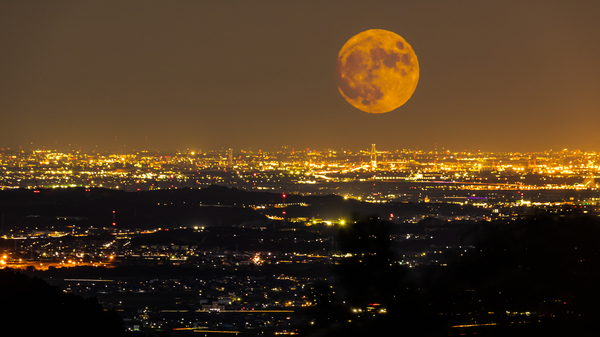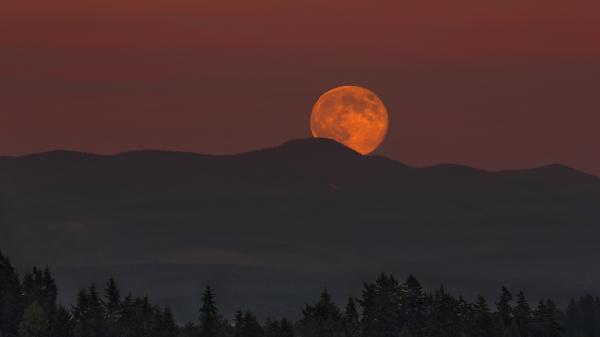The Harvest Moon 2025
The Full Moon closest to the September equinox is called the Harvest Moon. It is unique because the Moon rises close to the same time several days in a row.

The 2020 Harvest Moon over Yokkaichi City, Japan. The Japanese tradition of observing the Harvest Moon is called Tsukimi.
©iStockphoto.com/petesphotography
Jan 2025: See the planets at their best
When Is the Harvest Moon?
The Harvest Moon is the Full Moon nearest the autumnal (fall) equinox, which happens around September 22, depending on the year and time zone.
Harvest Moon 2025
2025年10月7日 (火)12時47分
Harvest Moon 2026
2026年9月27日 (日)1時49分
Times for the Harvest Moon vary by time zone. Times and dates are based on the local time in Tokyo. Change location
Why Is It Called the Harvest Moon?
Usually, Full Moon names reflect the time of year they happen. And, true enough, the Harvest Moon graces the skies in the harvest season in the Northern Hemisphere.
Chuseok: The Harvest Moon festival causing a traffic chaosThere is also an astronomical reason why the Full Moon closest to the autumnal equinox is called the Harvest Moon.
Several “Full Moons” in a Row
On average, the Moon rises about 50 minutes later each day. At Full Moon, it rises as the Sun sets. In the Northern Hemisphere around the Harvest Moon, however, the difference in the time of moonrise from one day to the next is less than 50 minutes.
At the latitude of Edinburgh in the UK, the Moon rises about 10 minutes later each day. At the lower latitude of New York in the USA, the difference is around 25 minutes per day.
With successive moonrises coming around the same time of day, it may feel like there are several Full Moons in a row. Historically, the extra moonlight meant that farmers could work and harvest their crops for a longer time in the evenings. Hence, the Harvest Moon.
Moonrise and moonset times in your location

The Harvest Moon may look red when it rises. This is because the Full Moon rises at sunset, and refraction causes more of the red sunlight to come through at that time, giving the Moon a red tint.
©bigstockphoto.com/jpldesigns
Sleep, crime, and menstruation: how Full Moons affect humans
The Moon’s Shallow Angle
Astronomers explain this Harvest Moon phenomenon by noting that, on September evenings, the ecliptic makes a shallow angle with the horizon in the Northern Hemisphere. The ecliptic is the path that the Sun—and, roughly speaking, the Moon—follow across the sky.
Another way to think about this is to think about the direction of Earth’s tilt.
Earth Tilts to the Moon
Our planet’s spin axis—the imaginary line connecting the North and South Poles—is tilted. This is what gives us our seasons: when the North Pole is tilted toward the Sun, it is summer in the Northern Hemisphere; when the North Pole points away from the Sun, it is the Northern Hemisphere winter.
The Moon orbits Earth roughly once a month. At Full Moon, it lies on the opposite side of Earth to the Sun. This means that when Earth is tilted toward the Sun, it is tilted away from the Full Moon.
Is the Moon upside-down in the other hemisphere?
Full Moon Gaining Time
So, how do the Moon’s phases line up with Earth’s tilt in September? Just as the Sun spends more time above the horizon in summer than in winter, the Moon spends different amounts of time above the horizon depending on its phase.
Around the September equinox, the North Pole is tilted away from the Moon at First Quarter, and toward the Moon at Third Quarter. As a result, in the Northern Hemisphere, the Third Quarter Moon spends more time above the horizon than the First Quarter Moon. To gain this extra time, it rises earlier than usual during the intervening period, with the earliest moonrises of all coming around Full Moon.
A Culturally Significant Full Moon
The Harvest Moon is probably the most known of the Full Moon names inspiring films, a Nintendo Switch game, and songs—including Neil Young’s Billboard hit “Harvest Moon.” There are many Harvest Moon festivals in the US with farmers’ markets, beer and wine tasting, craft fairs, concerts, and entertainment.
The September equinox coincides with many cultural events, religious observances, and customs around the world. For example, the Mid-Autumn Festival, also known as the Moon Festival, is a harvest festival celebrated worldwide in Chinese and Vietnamese communities on the day of the Harvest Moon.
How can Full Moon be in the daytime?
Hunter’s Moon in October
Most years, the Harvest Moon is in September, but around every three years, it’s in October.
When the Harvest Moon occurs in September, it replaces the Corn Moon. When it, less frequently, happens in October, it takes the place of the Hunters Moon.
When are the Full Moons this year?
12 Full Moon Names
The Full Moon has been integral to tracking the change of months and seasons since ancient times.
Today, we use many of these ancient month names as Full Moon names, and many of them come from the Colonial Americans adopting Native American names into their calendars.
Although the most commonly used Full Moon names are English interpretations of Native American names, some are also Celtic, Anglo-Saxon, medieval English, and Neo-Pagan.